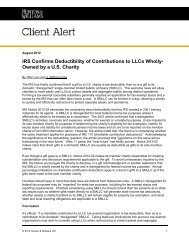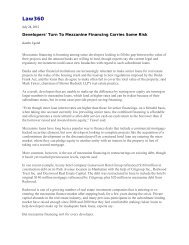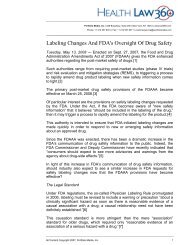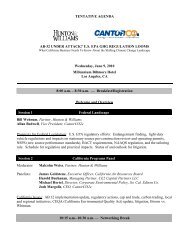Hunton & Williams Renewable Energy Quarterly, September 2009
Hunton & Williams Renewable Energy Quarterly, September 2009
Hunton & Williams Renewable Energy Quarterly, September 2009
You also want an ePaper? Increase the reach of your titles
YUMPU automatically turns print PDFs into web optimized ePapers that Google loves.
<strong>Renewable</strong> <strong>Energy</strong> <strong>Quarterly</strong><br />
18 months. Another 300 residents will have home meters<br />
that will gauge their consumption so they will have the option<br />
to manage their energy usage and thereby save money.<br />
The City University of New York will also participate in the<br />
pilot by testing the integration of solar energy into the city<br />
grid. The energy will be collected from a 100kW photovoltaic<br />
system on the roof of LaGuardia Community College.<br />
If the pilot proves a success, Con Ed hopes to bring the<br />
advances to the rest of the city. Since the announcement<br />
of the Queens project, Con Ed has applied for a total of<br />
$188 million in federal stimulus funds to support their overall<br />
$435 million smart grid program.<br />
Farmers Cut Costs and Emissions with Legislation<br />
Pending<br />
Climate change legislation has been the source of much<br />
debate in the agricultural community, but farmers have been<br />
making positive changes while lawmakers work out the<br />
details. Over the last few years, an increasing number of<br />
dairy farmers in Wisconsin have successfully lowered their<br />
operational costs with the use of biogas digester systems.<br />
The biogas engines generate enough power for on-site electricity<br />
needs and the excess power can often be sold back to<br />
the regional grid.<br />
In January a bipartisan group of U.S. senators introduced<br />
legislation to encourage the development of biogas, the<br />
Biogas Production Incentive Act of <strong>2009</strong>. If passed, the bill<br />
would encourage greater production of biogas for energy<br />
purposes by providing biogas producers with a tax credit<br />
of $4.27 for every million British thermal units of biogas<br />
produced. According to the U.S. Department of <strong>Energy</strong>, if the<br />
U.S. used half of its waste biomass, biogas could replace<br />
about 5 percent of the natural gas currently being used,<br />
reducing carbon dioxide emissions by another 45–70 million<br />
metric tons per year.<br />
U.S. Military and Investors Help Algae Research Grow<br />
On <strong>September</strong> 8 Solazyme Inc., a synthetic biology company<br />
specializing in algal biodiesel, announced that it had signed<br />
a contract with the Defense Department to develop 20,000<br />
gallons of algae-derived diesel fuel for testing. This contract<br />
is a symbolic leap forward for the advanced research and<br />
development of large-scale advanced biofuel production<br />
from algae. Earlier this year, the Defense Advanced<br />
Research Projects Agency (DARPA) awarded a $25 million<br />
contract to Science Applications International Corp. for the<br />
development of an algae-based jet fuel for the U.S. military.<br />
The military’s ultimate goal of energy independence continues<br />
to act as a catalyst for alternative energy pioneers like<br />
Solazyme.<br />
Algae are among the fastest-growing plants in the world.<br />
Approximately 50 percent of their weight is lipid oil, which<br />
can be used to make biodiesel for cars, trucks and airplanes.<br />
Many others are investing in the promise of algae. In July<br />
ExxonMobil and startup Synthetic Genomics announced<br />
more than $600 million for a five- to six-year algae biofuels<br />
development program, including more than $300 million to<br />
be invested into the startup. Bill Gates’ Cascade Investment<br />
has funded Sapphire <strong>Energy</strong>’s development of auto fuel from<br />
algae. In early <strong>September</strong>, Sapphire <strong>Energy</strong>’s green crude<br />
powered the world’s first algae-fueled vehicle — a modified<br />
Toyota Prius also know as Algaeus. Although it is premature<br />
to say we will conquer our dependence on foreign oil with<br />
algae, recent developments demonstrate it is a fuel with<br />
great potential.<br />
31 <strong>Renewable</strong> <strong>Energy</strong> <strong>Quarterly</strong> www.hunton.com
















